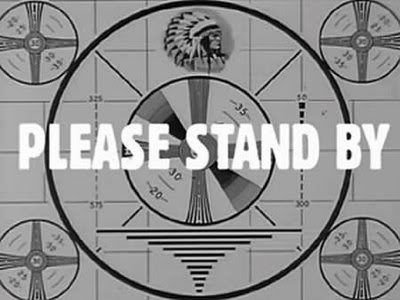|
|
Post by Dave Homewood on Jul 16, 2011 0:05:24 GMT 12
The RNZAF took delivery of Goster Meteor FIII in December 1945 and it first flew in New Zealand in 1946 as NZ6001. It was at this time on loan from the RAF. It was first flown by Sqn Ldr Bob McKay, sometime in January or February 1946.
In February 1946 six more pilots were selected to train on the aircraft. One of them was Sqn Ldr Allan 'Skip' Watson, CO of the Rocket School at RNZAF Station Ardmore. He first flew it on the 28th of Feb 1946 twice that day, and then on the 7th of March 1946. Then on the 17th of March 1946 he flew it a fourth time straight after flying Corsair NZ5662 in what is marked in his logbook as 'comparitive tests' between the two types.
My first question is who were the other five pilots at Ardmore who were selected with Skip to convert to the Meteor at this time when the aircraft was based there?
Sqn Ldr Bob McKay then took the aircraft on its famous national tour to show off jet power to the country. Following the March-May 1946 tour, a dedicated school was established at Ohakea called the Jet Propulson Unit. A further 50 pilots were apparently converted to the type here.
Does anyone have a list of the 50 pilots who converted to the Meteor at Ohakea?
Restrictions for high speed flight were put on the aircraft after problems with weakness developing in other FIII models overseas, and the aircraft was withdrawn from flying and put into storage in mid-1947 at Ohakea.
Now all of thos time the aircraft had still belonged to the RAF. However in 1950, after nearly three years of it being grounded in storage the RNZAF purchased the aircraft from the RAF at a cost of £5000.
Why, after all that time of no usage, did the RNZAF decide to buy the Meteor rather than keep the same loan arrangement, and was a Meteor that was obsolete, restricted of flyng anything more than a ferry flight, had been stored three years and only good for instructional airframe purposes (which is exactly where it went) really worth the whopping price of £5000?
Between its grounding in mid-1947 and the entry to service of Vampires in 1951, there must have been quite a let down for RNZAF pilots, especially those whod converted to the jet and then had to revert to piston aircraft. I wonder how many of the 57 pilots that had flown that aircraft were actually still in the RNZAF by the time the RNZAF got Vampires? I guess a lot of them must have gotten out as the doldrums of the interum Air Force took hold, and many might have gone to other Air Forces who had jets.
It's kind of interesting that NZ's jet age had an 18 month start then a four year lay off till jets finally returned to NZ skies.
|
|
|
|
Post by aeromedia on Jul 16, 2011 8:11:09 GMT 12
Good thread idea Dave and great questions, and from the answers I'm sure will surface here, eventually some great additional information to display with our aircraft.
|
|
|
|
Post by Richard Wesley on Jul 16, 2011 10:43:01 GMT 12
I've wondered the same question about the late purchase and always just assumed that they were locked into some contract? Will be interested to hear if there are other ideas?
|
|
|
|
Post by errolmartyn on Jul 16, 2011 12:33:51 GMT 12
For a detailed history of New Zealand's Meteor by Cliff Jenks see AHSNZ Journal for December 1984, pages 52-59.
There is no list of Meteor pilots as such but a number of them are mentioned in the text:
Sqn Ldr J J de Willimoff
Flt Lt A F Tucker
Wg Cdr R Webb
Flt Lt G W Annand
Flt Lt F J Adams
Wg Cdr J M Checkets
Flt Lt R K Walker
Flt Lt J P O'Donnell
Flt Lt H M Eccersall
Sqn Ldr J R Wenden
The author states that 56 RNZAF pilots underwent conversion on NZ6001.
The Air Ministry, incidentally, wanted £25,000 for the Meteor! The RNZAF counter-offered with £5000, aware that Australian and Canadian loan Meteors had already been written off.
Errol
|
|
|
|
Post by shamus on Jul 16, 2011 12:50:27 GMT 12
Not a lot of connection to the purpose of this thread but two photos of interest. One of the Meteor with its Instruction airframe number on and one of it at an unidentified NZ airfield.   |
|
|
|
Post by hairy on Jul 16, 2011 13:17:02 GMT 12
This may help Dave, the caption on the back of this photo is "RNZAF jet pilots, Ardmore" and was taken in February 1946. 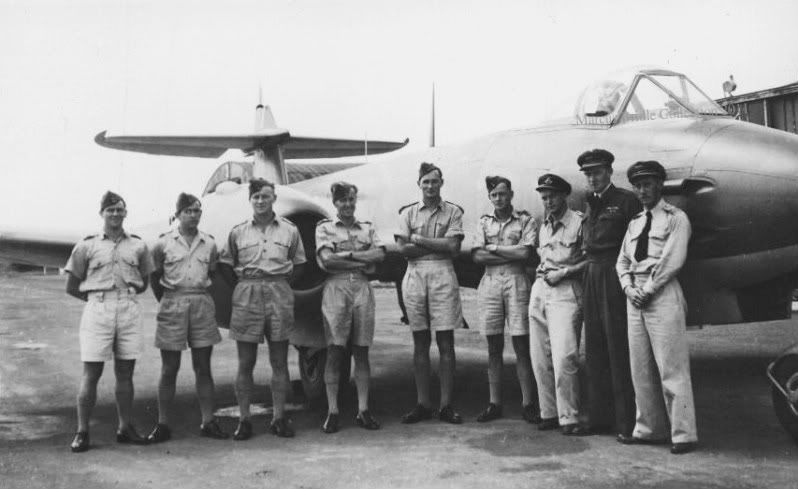 I'll fire up the scanner this evening and get some higher resolution close ups of the pilots for you.  |
|
|
|
Post by Dave Homewood on Jul 16, 2011 13:19:52 GMT 12
Thanks for the info and photos. Great stuff.
I know that Fred Tucker and Johnnie Checketts went on to Vampires. and though I have heard of most of those others names there I am not sure if any of them did so and will have to look further. Fred Adams was flying Vincents and Vildebeests in 1942, and the Meteor in 1946/47. That is quite a progression!
|
|
|
|
Post by errolmartyn on Jul 16, 2011 16:28:15 GMT 12
Here is an updated version of the list of Meteor NZ6001 pilots that I posted earlier. The additional names appear in a photo caption on page 4 of Whites Aviation magazine for April 1946.
Flt Lt F J Adams
Flt Lt F S Adeane
Flt Lt G W Annand
Flt Lt R Brabyn
Flt Lt R Bush
Wg Cdr J M Checkets
Sqn Ldr J J de Willimoff
Flt Lt H M Eccersall
Flt Lt J P O'Donnell
Flt Lt M Scannell
Flt Lt A Stanley
Flt Lt A F Tucker
Flt Lt R K Walker
Flt Lt A A Watson
Wg Cdr R Webb
Sqn Ldr J R Wenden
And of course not forgetting:
Sqn Ldr R M McKay
On page 17 of the March 19146 issue there are two photos that include seven RNZAF and four civilian New Zealand engineering/ground staff in Britain who were there in connection with jet research:
Wt Off M M Bentley, RNZAF (see also BSD) *
Flt Sgt H W Chadwick, RNZAF *
Flt Sgt C F Corne, RNZAF *
Wt Off H L Flanagan, RNZAF *
P J Hambleton (Greymouth)
G A Hookings (St Heliers)
Plt Off [R] J W Lindsay, RNZAF *
A I McCutchan (Onehunga)
N McKay (Wellington)
Fg Off R R Smith, RNZAF (see also BSD) *
Sqn Ldr W G Woodward, RNZAF (see BSD) *
* = salied for UK on Ruahine on 20 Feb 1944.
BSD = Colin Hanson's By Such Deeds - Honours and Awards in the Royal New Zealand Air Force, 1923-1999
BSD also includes another New Zealander who played a prominent part in the development of the jet in Britain. He began his air force career as a member of the NZAF in 1927. He was:
WATT, Group Captain George Ernest, CBE, AFC, LofM(US), RAF. 05232; Born Frankton, 10 Feb 1908; NZAF 21 Nov 1927 to 27 Feb 1933; RAF 28 Feb 1933 to 19 Jul 1954; Pilot, Engineer.
On loan to the RNZAF 10 May 1947 to 16 Mar 1950.
Citation Air Force Cross (1 Jan 1942): [Ministry of Aircraft Production] Wing Commander Watt was the pilot who tested the apparatus for the Flying Personnel Research Committee at the Royal Aircraft Establishment. He did over 100 ‘blacking-outs’ in the air over the period of a year to assess the value of positioning and various appliances. It was due to his courage and determination, often a great personal risk, that these tests were concluded satisfactorily.
Citation Legion of Merit (Degree of Officer) (US) (24 Jan 1947): For exceptionally meritorious conduct in the performance of outstanding service rendered to the Government of the United States in the United Kingdom as Deputy Director of Special Projects, Ministry of Aircraft Production in 1943-44, and as Head of Turbine Engine Development, Directorate of Engine Development, M.A.P. (now Ministry of Supply) from March 1944 to date. Group Captain Watt as the officer immediately responsible for the development of all aviation turbine engines for the British Government has been in the closest possible contact with the United States Naval Air Attaché, his technical staff together with the many engineering officers from the Navy Department, and representatives of naval contractors who visit the United Kingdom in order to study the design of turbine engines and jet propulsion in general. Group Captain Watt and his staff were continuously escorting American officers to the various centres of jet propulsion activity in England, and furnishing technical information on the subject. In his efforts to assist the American authorities Group Captain Watt has made several visits to the United States. By his wholehearted co-operation with American plans to undertake the design and production of aviation gas turbines, Group Captain Watt has made a very high contribution to the common war effort.
Citation Commander of the Most Excellent Order of the British Empire (16 Jun 1949): Not available. For services as Director of Technical Services, RNZAF, May 1947-Feb 1950 and for his research and development work on jet engines.
Gp Capt Watt was one of the first 10 pilot trainees recruited for the NZAF in Nov 1927 and learned to fly at Wigram. Following service with 18 Sqn RAF (Hart) in 1933-1936 he began to specialise in engineering, taking courses at the RAF School of Aeronautical Engineering and at the Imperial College of Science and Technology.
Gp Capt G E Watt, CBE, AFC, LofM(US), BE, DIC, CEng, FRAeS, as a New Zealander in the RAF, was the first officer to hold the post of Director of Technical Services, RNZAF. He was also a Past President of the NZ Division of the Royal Aeronautical Society. The Society’s Group Captain Watt Award was established in commemoration of the close association of members of the RNZAF with RAF technical teams who were engaged on the research and development of the jet engine during WWII. The citations above make mention of this wartime research. The purpose of the Group Captain Watt award is to recognise outstanding technical merit which enhances the efficiency of the RNZAF.
Died Howick, Auckland, 9 Nov 1990.
Also in Britain and who flew Meteors before war's end, and was CO of 616 Sqn, RAF, was Warren Schrader, RNZAF. Were there perhaps other New Zealanders who flew the type there before VE-DAY?
Errol
|
|
|
|
Post by Dave Homewood on Jul 16, 2011 17:55:44 GMT 12
Judging by the hangars in the background of your shot Marcus it looks to be Whenuapai or Ohakea rather than Ardmore?
|
|
|
|
Post by 30sqnatc on Jul 16, 2011 19:05:32 GMT 12
Sorry just a little off topic. The jet converson took place just one year after the war and all the pilots are officers so I assume the RNZAF stopped having NCO pilots when the war finished.
What happened if NCO pilots who wished to continue serving as pilots, were they automatically commissioned?
|
|
|
|
Post by hairy on Jul 16, 2011 20:02:43 GMT 12
Judging by the hangars in the background of your shot Marcus it looks to be Whenuapai or Ohakea rather than Ardmore? Definitely Ardmore, here is another shot from the same series showing hangar 2, the hangar in the background of the Meteor pilots picture is Hangar 3.  Here are some quick and dirty higher resolution scans of the pilots. 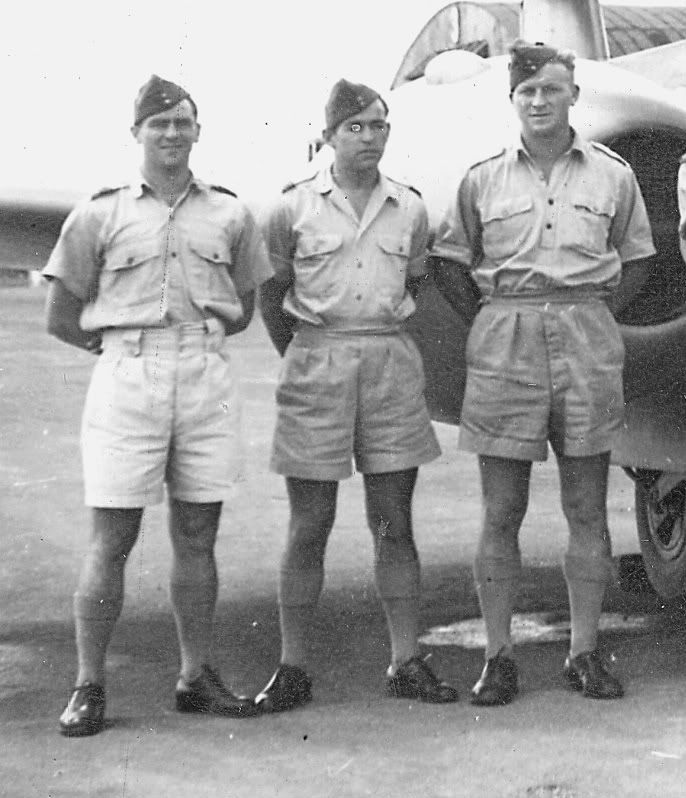 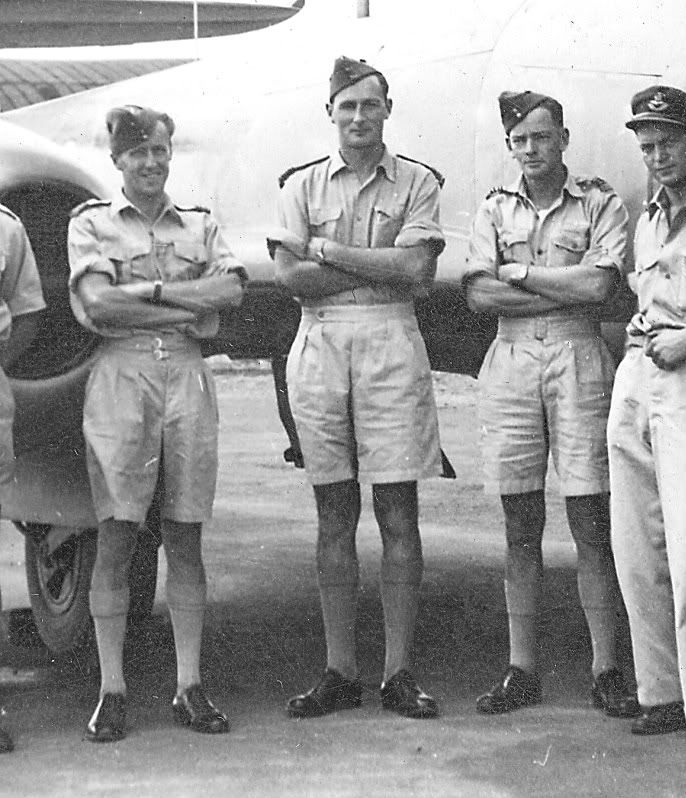 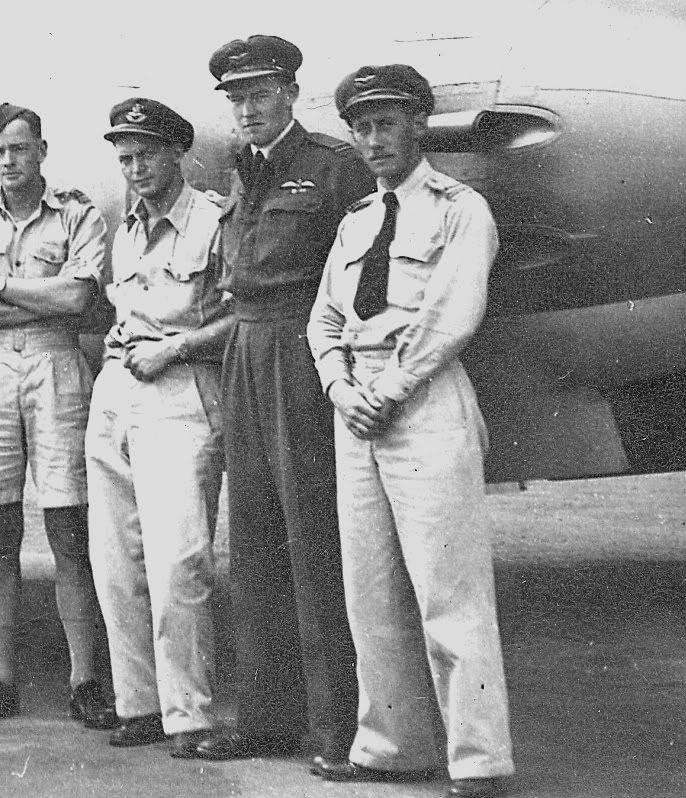 One thing I have noticed is how "bitsa" RNZAF uniforms were immediately after the war, there is about 4 different styles of shorts on those pilots.  |
|
|
|
Post by errolmartyn on Jul 16, 2011 20:10:48 GMT 12
This may help Dave, the caption on the back of this photo is "RNZAF jet pilots, Ardmore" and was taken in February 1946.  I'll fire up the scanner this evening and get some higher resolution close ups of the pilots for you.  This photo is the same as the one I mentioned earlier as featuring on p4 of the April 1946 issue of Whites Aviation magazine. The captioned names from left to right are: A A Watson, W Annand, R Brabyn, R M McKay, R Webb, F S Adeane, A Stanley, M Scannell & R Bush. And yes, caption confirms at Ardmore. Errol |
|
|
|
Post by aeromedia on Jul 16, 2011 20:45:10 GMT 12
Just as a small aside of interest, Frank Adeane in the picture above, was an instructor on Tigers at No 2 EFTS Ashburton. When the Ashburton Aviation Museum purchased our Commemorative Tiger Moth back in the early 2000's, Frank was in the front seat for the much-heralded official arrival into Ashburton. He mentioned then that he had flown NZ 6001.
|
|
|
|
Post by aeromedia on Jul 16, 2011 20:50:41 GMT 12
I spoke with Sir Tim Wallis at Gavin Johnston's farewell a few years ago and when the subject of acquiring a Meteor to represent the dawn of our jet age in NZ came up, he enthusiastically recalled seeing NZ6001 at Invercargill when he was a young fella.
|
|
|
|
Post by Dave Homewood on Jul 16, 2011 22:18:34 GMT 12
Thanks for the correction Marcus, and all the good info Errol and Peter.
|
|
|
|
Post by angelsonefive on Jul 16, 2011 22:27:08 GMT 12
The R.Bush at Ardmore is probably Roy Bush who flew Hurricanes in the B. of B. with 242 Squadron under the command of Douglas Bader, and was killed when his Oxford broke up in flight over the Ruahines in '47.
@ 30sqnatc. I have seen a pic. somewhere, possibly on this forum, of RNZAF Vampires over Cook Strait on their way to a flypast over Wgton. The caption, I remember, named one of the pilots as Sergeant Somebody, so I presume that the Air Force still had NCO pilots into the Vampire era.
The G.A.Hookings mentioned will probably be Gordon Hookings, so prominent in the gliding scene here for many years.
S/L McKay, as you probably know Dave, later became the Sergeant at Arms in our Parliament, and amongst other duties announced the entrance of the Speaker of the House at the beginning of each session of Parliament with the cry "Mr Speaker ! ".
M. Scannell is another familiar name from my reading of books about the RAF in WW2. I think this is Max Scannell mentioned by, as I recall, Pierre Closterman in his best-selling book "The Big Show".
Finally I can recall seeing, as a kid, the Meteor flying over Wanganui at a height of what could have been no more than 200 feet AGL.
Nowadays such a thing would create national furore with the talking heads of our abysmal TV news and the chattering classes
rabbiting on about it for days.
|
|
|
|
Post by shorty on Jul 16, 2011 22:44:27 GMT 12
"Sergeant Somebody" was Sergeant Pilot Magon. Date was Jan 12 1954 and the occasion was a flypast by 75 Sqn for the opening of parliament by the Queen
|
|
|
|
Post by Dave Homewood on Jul 16, 2011 23:24:13 GMT 12
There were several Sgt Pilots in Cyprus with No. 14 Squadron.
|
|
|
|
Post by Dave Homewood on Jul 18, 2011 14:03:32 GMT 12
A nice photo from Skip Watson's collection: 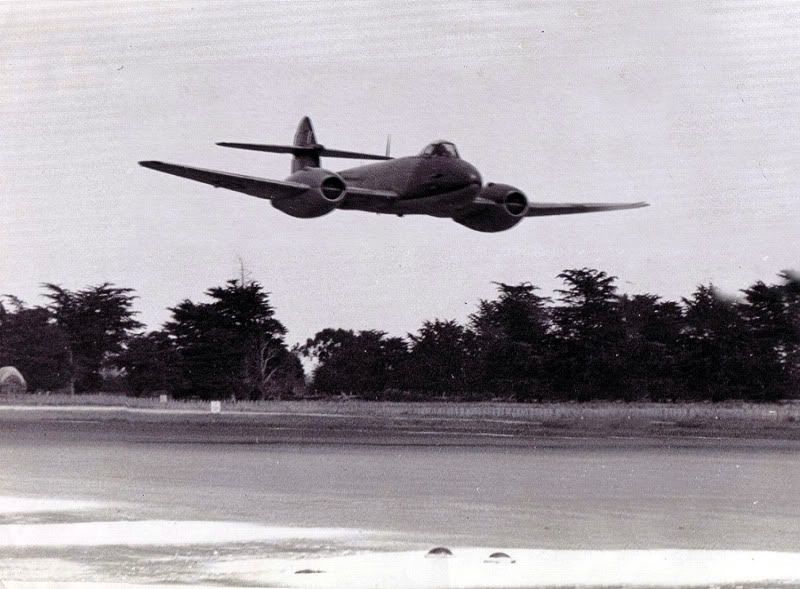 |
|
|
|
Post by Dave Homewood on Jul 18, 2011 14:38:59 GMT 12
The R.Bush at Ardmore is probably Roy Bush who flew Hurricanes in the B. of B. with 242 Squadron under the command of Douglas Bader, and was killed when his Oxford broke up in flight over the Ruahines in '47. It could also have been Flt Lt Ronald George Bush who was a P-40 and Corsair pilot and served till 8th of October 1946 according to By Such Deeds by Colin Hanson. Roy Bush was probably already a Sqn Ldr by the time he transferred to the RNZAF in march 1946, I'd have thought, as he was a Flt Lt in 1941. |
|







